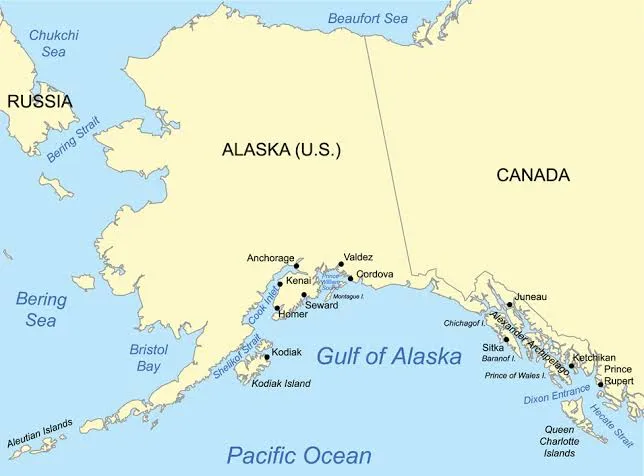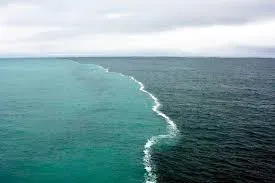
The Gulf of Alaska is an arm of the Pacific Ocean defined by the curve of the southern coast of Alaska stretching from the Alaska Peninsula and Kodiak Island in the West to the Alexander Archipelago in the East (with the Glacier Bay and the Inside Passage).
The entire shoreline of the Gulf is a rugged combination of forest, mountains and glaciers. Many deep water corals can be found in the Gulf of Alaska. The Gulf of Alaska is also considered as Class I, i.e. highly productive ecosystem of more than 300 grams of carbon per square meter per year.
The Gulf of Alaska is prone to heavy rains and snow storms that engulf the southern and south central Alaska. It also holds the largest Tsunami recorded in history with a wave of 1720 feet tall.

Water bodies flowing from different sources often meet at a point (confluence) and flow together. Normally, the waters are to mix together and there should be nothing special about it.
However, water bodies with extremely different properties have been seen to meet without properly merging into each other such as:
- Confluence of the Green and Colorado Rivers in Canyonlands National Park, Utah, USA
- Confluence of the Jialing and Yangtze Rivers in Chongqing, China
- Confluence of the Alaknanda and Bhagirathi Rivers in Devprayag, India
and others.
One of the most perfect example is the Gulf of Alaska. Two water bodies of different colour, temperature and density meet and do not mix.
Foam or froth is formed at the point of intersection showing that the waters collide against each other rather than mix.
One of the waters is fresh, rich in minerals, sediment-laden, light-blue coloured with low density originating from melting glaciers and the other, salty, dark-blue coloured with high density from the ocean. With these two opposing properties at different temperatures, mixing would definitely be a great challenge.
As others see this phenomenon as a miracle from God, the Creator, scientists called this a myth.
In the quest of busting this myth, after much study, they found out that the waters eventually mix after the varying properties reach an equilibrium. Although, this is not so obvious.